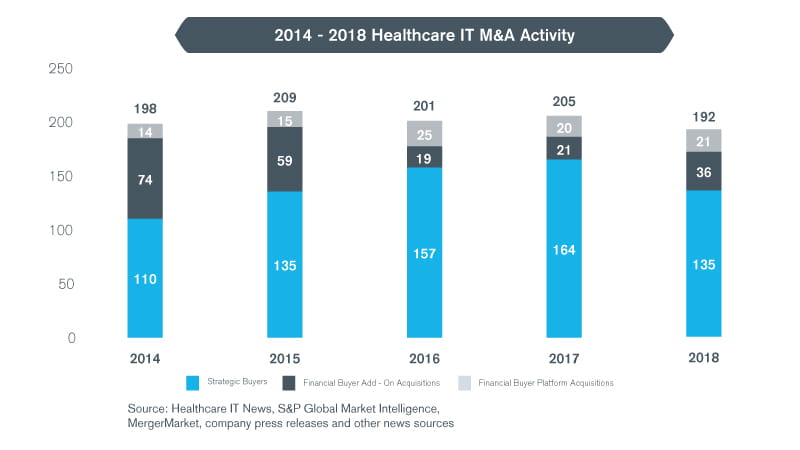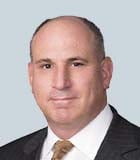M&A activity in 2018 remained healthy in the $40 billion wellness sector.1 Big players used M&A to get bigger, and private equity investors played both sides of the trade–selling assets to realize gains and buying platforms to effect consolidation. Consolidation has been driven, in no small part, by employers’ desire to reduce the number of benefits vendors they use. Consolidators have acquired best-in-class point solutions to integrate into end-to-end solutions. Continued tightening in the U.S. labor market added to industry momentum. Unemployment ended the year at 3.9%,2 real average weekly earnings grew by 1.2% in 2018.3 Employers looked for benefit packages that included wellness offerings to recruit and retain employees.
For perspective, employers are the largest conduit for healthcare coverage in the U.S. According to the Kaiser Family Foundation, 56% of the non-elderly population in the U.S., more than 152 million people, received health insurance coverage from employers in 2016.4 In addition, 60% of workers covered by employers are in self-funded plans,5 meaning that the employer, not an insurance company, is responsible for the cost of healthcare not funded by employee-paid premiums, co-payments and deductibles. Self-funding skews heavily toward large employers – 91% of employers with 5,000 or more workers are self-funded, versus 23% of employers with 50 to 199 workers.5
Large employers also represent a larger share of the market for employee wellness programs – 62% of large employers (200 or more workers) offer health risk assessments and 50% of large employers offer biometric screening to employees, as compared to 37% and 21%, respectively, of small employers (50-199 employees).4 Large employers with wellness programs have a
significantly higher adoption rate, and 48% of them reported using a third-party wellness provider (as opposed to an insurance company, TPA or self-administration) as compared to 28% of small employers.6
The data above suggest that serving large employers could be lucrative is for wellness providers, which could at least partially explain vendor consolidation, as certain wellness program providers using M&A to increase their scale in order to add capabilities to better serve the needs of large employers.
Benefit plans are a valuable tool that employers use to recruit and retain talent. According to a 2016 survey by Glassdoor,7 57% of respondents reported benefits to be among the top considerations in accepting a job. As more wellness offerings have been incorporated into benefit plans in response to the progressive tightening of the labor market, wellness has become well-being. Health risk assessments, biometric screening and weight loss and smoking cessation programs have been joined by mental health, sleep management, mindfulness and financial wellness programs in many benefit plans, not only to recruit and retain, but to foster employee engagement and enhance productivity. In response, third-party vendors have added these and other capabilities organically and via acquisition.
Software has been an important enabler for vendors as they scale programs across large employer groups. This was one of the stated drivers of the November 2018 acquisition of SimplyWell, a portfolio company of Frontier Capital, by Marlin Equity Partners, which merged the business with its Virgin Pulse wellness portfolio company. In the press release announcing the deal, Marlin said, “The acquisition of SimplyWell allows us to add immediate scale and critical product features to the Virgin Pulse platform and accelerates the time to market of key clinical-focused capabilities for our customers in the near-term.” Earlier in the year, when Marlin acquired and merged venture capital-backed RedBrick and Virgin Pulse, it cited similar dynamics: “Bringing RedBrick’s live and digital coaching and benefits navigation together with Virgin Pulse’s mobile-first, daily engagement platform allows us to deliver the industry’s only global, one-stop-shop for employees and employers.”
This is not to say that the large employer market is the only game in town. According to data published by the National Center for the middle market, employers with revenue between $10 million and $1 billion were responsible for one-third of all U.S. jobs. Midsized enterprises have similar human capital needs as large enterprises but may have less of a need to scale solutions due to the size of their employee populations. Hence - in the middle market - while software enablement is still important, wellness programs with high-touch customized services can play a bigger role. Employers also place a high priority on data security and a vendor’s ability to provide a consistent, engaging experience across an enterprise that might consist of a multigenerational workforce. Millennials, GenXers, GenYers and baby boomers may work for the same company, but they have different wellness needs and respond differently to digital cues.
Looking to 2019, we anticipate wellness sector M&A activity will likely continue. The market is still highly fragmented, and not all small vendors will be able to make the investments required to keep their programs competitive with larger vendors as downward pricing pressure persists. Smaller vendors will seek M&A at an increasing rate in 2019, taking advantage of a still-strong employment market and with the knowledge that economic expansions do not last forever. The current expansion, which began in June 2009, is the second longest recorded by the National Bureau of Economic Research. It is only logical that it will come to an end at some point, be it later in 2019 or in 2020. Declining employment would hurt wellness vendors in several ways. Fewer employees means fewer Per Member Per Month dollars and employers will push even harder for lower rates. Finally, in a less competitive labor market, employers may view wellness benefits as a luxury rather than a necessity.
Nonetheless, the long-term outlook for well-being benefits is strong. Recessions tend to be 12- to 18-month events and important industry trends will survive through the economic cycle. Top talent is always in short supply, a healthy and engaged workforce can enhance productivity, the healthcare cost curve has not been bent downward and wellness is an important cost-containment tool. Finally, the expectations of the rising generation of labor force participants are significantly different than those of the retirees they are replacing, and well-being benefits will be an increasingly key factor in selecting an employment opportunity.
Read the report for more detail on sector activity.

Sources:
1 Global Wellness Institute
2 Bureau of Labor Statistics press release dated January 18, 2019
3 Bureau of Labor Statistics press release dated January 11, 2019
4 http://files.kff.org/attachment/Supplemental-Tables-The-Uninsured-A-Primer-Key-Facts-about-Health-Insurance-and-the-Uninsured-Under-the-Affordable-Care-Act
5 2017 Annual Survey Employer Health Benefits – The Kaiser Family Foundation
6 2018 Annual Survey Employer Health Benefits – The Kaiser Family Foundation
7 https://www.glassdoor.com/blog/glassdoors-5-job-trends-watch-2016/
Corporate Finance and Restructuring
M&A advisory, restructuring and insolvency, debt advisory, strategic alternatives, transaction diligence and independent financial opinions.
Mergers and Acquisitions (M&A) Advisory
Kroll’s investment banking practice has extensive experience in M&A deal strategy and structuring, capital raising, transaction advisory services and financial sponsor coverage.
Healthcare Investment Banking
Healthcare expertise for middle-market M&A transactions.
Transaction Advisory Services
Kroll’s Transaction Advisory Services platform offers corporate and financial investors with deep accounting and technical expertise, commercial knowledge, industry insight and seamless analytical services throughout the deal continuum.
Fairness and Solvency Opinions
Duff & Phelps Opinions is a global leader in Fairness Opinions and Special Committee Advisory, ranking #1 for total number of fairness opinions in the U.S., EMEA (Europe, the Middle East and Africa), Australia and Globally in 2023 according to LSEG (FKA Refinitiv).
Financial Sponsors Group
Dedicated coverage and access to M&A deal-flow for financial sponsors.
Distressed M&A and Special Situations
Kroll professionals have advised hundreds of companies, investors and other stakeholders at all stages of distressed transactions and special situations.
Private Capital Markets – Debt Advisory
Kroll has extensive experience raising capital for middle-market companies to support a wide range of transactions.


